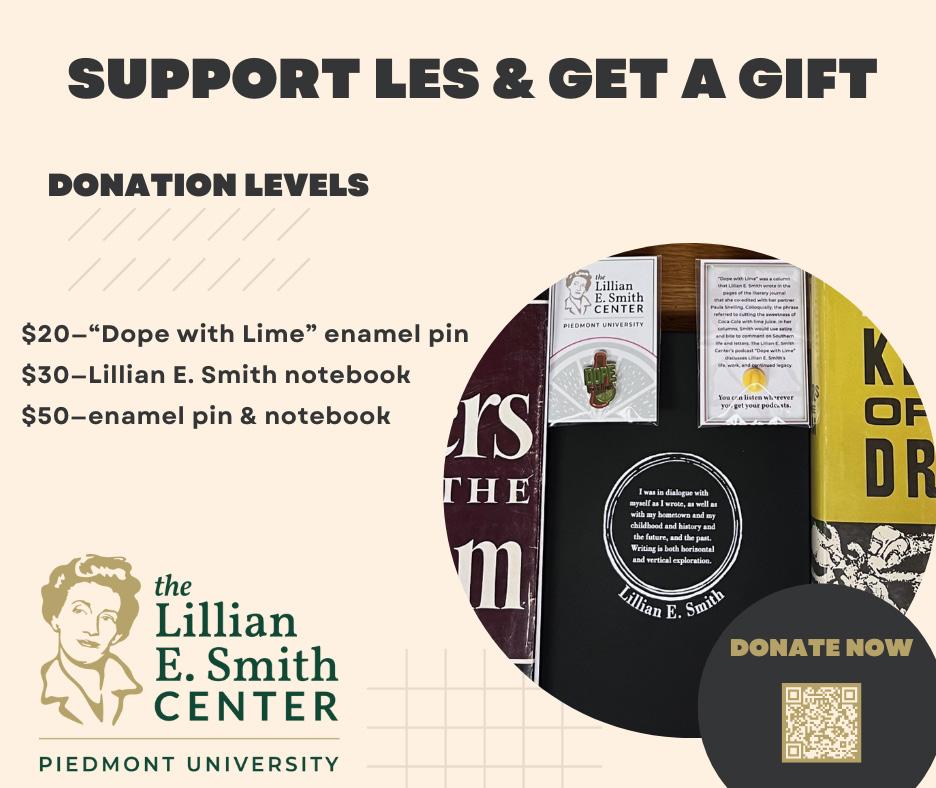

A View From the Mountain
a newsletter from the Lillian E. Smith Center
Lillian Smith’s Enduring Legacy -
Matthew Teutsch

What makes Lillian Smith’s work endure? What makes any writer’s work endure? The relationship between an author and their text, and a text and its audience, is a cooperative experience — they hold hands, speaking to one another in a circle. This “collaboration of the dream,” as Smith refers to it in “Trembling Earth,” encourages artist and audience to collaborate in the construction of meaning.
Writing in the 1961 reissue of her memoir Killers of the Dream, Smith states that she composed her memoir as a means of self-discovery: “I wrote it because I had to find out what life in a segregated culture had done to me, one person. I had to put down on paper these experiences so that I could see their meaning for me. I was in dialogue with myself as I wrote, as well as with my hometown and my childhood and history and the future, and the past.” Smith’s unflinching exploration of herself and the experiences that shaped her are what make Killers of the Dream, Strange Fruit, and The Journey works of art that endure to this day. She infuses each of them with an honesty that allows her audience to follow her own exploration into herself while also exploring themselves.
Planned Giving
Planned gifts are a perfect way to provide fellowships for artists in residence at the Center or scholarship funds for students enrolled in the Lillian E. Smith Scholars Program at Piedmont University.
DIRECTOR OF LILLIAN E. SMITH CENTER
Matthew Teutsch
mteutsch@piedmont.edu | 706-8944204

LES ADVISORY BOARD
Matthew Teutsch, Chair
Marshall Criser
Rebecca Brantley
Marie Cochran
Nannette Curran
Nancy Smith Fichter
Margaret Rose Gladney
Rebecca Godwin
Shaleen McCormick
Jane McPherson
Susan Montgomery
In 1953, during the composition of The Journey, Smith was diagnosed with “a malignancy of the breast.” She told Lewis Gannett in December of that year, “Cancer is the only big fear I had ever had. Always I had felt I could take anything but that.” While Smith does not address her cancer directly in The Journey, it hovers over her words, casting a shadow over her search for that which could “fuse past and future, and art and science, and God and one’s self into a purposeful whole.” She went in search of the answers to questions about her very being, our very being. As she told Gannett, “I knew what I did not believe; I thought I even knew what was ‘wrong with things’ but I did not know what I believed, nor did I know what is ‘right with things.’ So I journeyed forth to find out.”
During a 1962 television interview, Dick McCuthchen asked Smith if she had ever thought about leaving the South as so many others had done before her. Smith told him that if she moved to New York or Paris instead of remaining at home in the mountains of North Georgia that “all of it would begin to fade,” the memoires, the feelings, but most importantly the hurt. She acknowledged that remaining in the South hurt, but she continued by stating, “I wanted it to hurt, because I think a writer stops writing when the wound heals, and we must keep the wound open.” To write, to conduct the journey, no matter what that journey may be, the artist must “hurt,” and the wound must not heal, because when the wound remains open, Smith says, one becomes “aware of these deep injuries.” Through this manner, the artist conveys a balm for the cultural wounds, a medication for the wounds. The artist works to suture the wounds that impact us as a society. To convey those healing aspects, the artist must keep their own wound open, refusing to let it scab over and heal. They must constantly pick at it, reopening it and letting it bleed, spewing forth the pain, the hurt, and the suffering to provide the salve for society to heal.
Even though Smith bristled at critics and the public labeling her as a “race writer” because she wanted them to view her merely as an artist, she kept the wound open for all to see. She let it burst forth in her essays, her speeches, her latter books such as Our Faces, Our Words. She exposed herself to the wound to discover more about herself and in that discovery, she exposed whites to white supremacy and its impact on them. She faced the hurt, as artists do, to make the world better. She used her home roots to fuel her imagination and writing, but she wanted her ideas to span the world, to reach beyond region and into the psyches of those across the globe, and she did this.
Speaking with Studs Terkel in 1961 about the impact of Strange Fruit then the dismissal of Killers of the Dream, Smith says that both books “disturbed” readers and that people, in the early 1960s, have started to accept her and refer to her as “the sweet little lady who has done so much about race relations,” and as a result people don’t need to read her books anymore. To this, Smith says, “Now that is an acceptance I call death, you see. Death to the writer. Death comes to the writer when people stop reading her books.” Memory and the past hover over all of Smith’s work, the ways we remember those who came before and keep their stories alive, thus keeping the person alive. For Smith, when people stop reading her work, thinking about it and communicating with it, then she will die. Death will not end her life. No, the refusal to read her will do that.
A passage from The Journey is on Smith’s tombstone, and it reads, “Death can kill a man, that is all it can do to him. It cannot end his life because of memory.” The physical may pass on, but the memory remains, embedded in the hearts and minds of those who knew and loved the artist and their audience. Shakespeare died, physically, in April 1616, over 400 years ago, yet he is not dead. His memory remains. So does Smith’s memory. She died, physically, almost sixty years ago, but her memory remains, thus she is not dead. If, when we stop reading an author the author dies, then Smith remains alive, communicating with us to this very day. She is part of us as we are part of her, disconnected by the horizontal plane and the passage of time yet connected through the vertical plane and the spiritual.
While Smith saw the creative act as an exploration of the internal self in relation to the external self, she also understood that “[w]riting is,” as she put it in the 1961 reissue of Killers of the Dream, “both horizontal and vertical exploration.” She saw writing as a means of merging both the temporal and the eternal, the earthly and the spiritual. Art, no matter the form, serves as a way for us to explore the human condition, to link us both to things seen and unseen. Smith’s art endures because she imbued it with herself and everything that informed her identity, past and future. She endures because she confronts the difficult questions of our existence and calls upon us to step outside and follow her journey of discovery.


Celebrating Lillian E. Smith
2024 marks the 80th anniversary of Smith’s debut novel Strange Fruit, the 75th anniversary of Killers of the Dream, and the 70th anniversary of The Journey. The Lillian E. Smith Center is scheduling various events over the course of 2024 to commemorate these anniversaries.
Celebrating Lillian E. Smith” was the first celebration this year of Smith’s legacy and work. More events are planned for the fall, specifically an exhibit at the Mason-Scharfenstein Museum at Piedmont highlighting works of art from Smith’s collection.
The community attended events at the Georgia Center for the Book in Decatur and at the Mason-Scharfenstein Museum of Art at Piedmont University in Demorest. The latter of which was recorded for the center’s podcast “Dope with Lime.”
“Lillian Smith’s work echoes through the decades and remains relevant today,” said Dr. Matthew Teutsch, Director of the Lillian E. Smith Center. “These celebrations will be an opportunity to introduce Smith to new audiences and to revisit her prescient observations about the human condition.”
Presenters included Rev. Dr. Benjamin Boswell, pastor at Myers Park Baptist Church in Charlotte, Dr. Keri Leigh Merritt, historian and author of an upcoming biography on Smith, and Dr. Jennifer Morrison, Assistant Professor of English at Xavier University in Louisiana.
Make sure to follow us on social media for information about upcoming events. If you would like to schedule an event celebrating Lillian E. Smith, contact us at lescenter@piedmont.edu.


Writer-In-Service Award
- Dr. Qiana Cutts Givens
Senior biology student Sam Rideout is tracking mixed species foraging flocks through the ravines and bottomland forest at LES. Sam (pictured here listening for bird calls along the Reservoir Loop) and his research advisor, Natural Science Professor Tim Menzel, were at the LES Center on October 19 working on his project. They encountered a large flock of birds made up of eight different bird species, including blue-headed vireos and golden crowned kinglets, in the area of the old swimming pool along the bottomland loop. The LES Center provides over 100 acres of undisturbed hardwood forest, which is home to many songbird species and full of the sounds of birds all year!
The flowers pictured here are soapwort gentians, which grows in a wet area along the Bottomland Loop, where the water seeps out of the mountainside. They bloom every year at LES in late October. The seeps in LES’s bottomland area are a unique wetland habitat that hosts a variety of wetland associated plant and animal species. Along with the gentian, the seeps are a breeding ground for the Louisiana waterthrush, a ground nesting warbler species that prefers wooded swamps and stream side habitats.

Gabriele Stauf Residency Award
- Dr. Jaye Johnson Thiel

Dr. Jaye Johnson Thiel is the 2024 recipient of the Gabriele Stauf Residency Awrd. Thiel is an Assistant Professor of Early Childhood Studies at the University of Alabama. Her scholarship explores children and youth hobbies, art making, and play to rethink how educators and communities might develop practices and policies that expand our understandings of the constructions of childhood in the Southeastern United States. Jaye has published many articles and chapters in her field, including coediting the book: Posthumanism and Literacy Education: Knowing/Being/ Doing Literacies. Jaye received her PhD at the University of Georgia. Before receiving her PhD, she was an educator (PK-grade 5) and before that she proudly worked in the service industry, including taking orders for bus parts, sweeping hair, and serving food at a local restaurant.
The Gabriele Stauf Residency Award provides a complimentary two-week retreat at the Center for an educator who is working on a project that would benefit from a residency. Gabriele Stauf, Professor Ermerita of English at Georgia Southwestern State University, and she sponsors this annual award because she understands the value of time and solitude required for creative pursuits.
McClure-Scanlin Visual Artist Residency Award
- Sukanya Mani
Sukanya Mani is the 2024 recipient of the McClure-Scanlin Visual Artist Residency Award. On receiving the award, Mani wrote,
I am a St. Louis-based, Indian born, interdisciplinary artist. I strongly believe that art can be an agent for change. I seek to activate public and private spaces in ways that are engaging, immersive, and contemplative.
My characteristic approach balances formal composition, theatrical staging and an innovative use of unexpected materials. While my installations suggest a preoccupation with abstraction, they also reveal a continuous and nuanced engagement with migration, politics and identity. I integrate the process of moving from feminist values into actions based on those values into my work through intentional choices, educational endeavors, and empowerment initiatives. My work explores social constructs of gender roles and identity.

My artistic journey started with hand cut paper informed by materials, location and the installation process. My work explores how creativity impacts space, often through the act of cutting and installation. Transforming the violent act of cutting into an act of creation is central to my artistic approach. Light, space, time and gravity are used as conceptual forces in my installations.
My most recent work incorporates cut paper, repurposed fabric, technology and found objects into the installations. Ultimately, through the delicate manipulation of space, I seek to evoke empathy, spark conversations, and inspire action.
The McClure-Scanlin Award is made possible through a generous gift to Piedmont College from Tommye Scanlin and her
Emily Pierce Graduate Student Residency Award

- Pujarinee Mitra
Pujarinee Mitra is the 2024 recipient of the Emily Pierce Graduate Student Residency Award. She is a PhD student and Graduate Instructor at Texas A&M University, College Station. Her research focuses on feminist rage in South Asian anti-fascist resistance, with publications in Humanities, Journal of Comparative Literature and Aesthetics, and Feminist Encounters. Her interests include Postcolonial Literature, South Asian Literature and Cinema, Gender and Sexuality Studies, Cultures of Fascism and Anti-Fascism, and Affect Theory.
Named after one of the first Lillian E. Smith Scholars, the Emily Pierce Graduate Residency provides the opportunities for graduate students whose work moves us towards a more equitable society. It includes a complimentary two-week retreat at the Center and an honorarium.
Chimney Garden
The chimney, the lone remaining part of the Laurel Falls Camp for Girls’ gym, has been a fixture of the center for years. Lillian Smith kept the chimney standing, both as a testament to the legacy of the camp and as a work of art, drawing individuals to the place. In fact, Smith is buried next to her beloved chimney.
In the 1960s, Joan Titus and others proposed and planted the chimney garden to remember Lillian Smith. Since then, the chimney garden has gone through different iterations. Over the past couple of years, thanks to a generous donation from John Siegel and John Templeton, we have revitalized the chimney garden, making it a space for visitors to commune with Smith and those who came before.
If you would like to donate to the ongoing upkeep and maintenance of the chimney garden, mark your donation to the center as “Chimney Garden.”



RETURN SERVICE REQUESTED

Opportunity
to Support Our Work at the LES Center
This past year, we at the Lillian E. Smith Center have erected a historical marker honoring Lillian E. Smith, partnered with local organizations on programming such as a week-long professional development program for Georgia educators, provided programming for students and faculty at Piedmont University, and more.
We could not do any of this without your continued support. This year, our goal is to endow our four residency awards so we can maintain them in perpetuity. We need $25,000 to endow each award separately and $100,000 to endow all four at one time. Doing this would initially provide each award recipient with a $500 honorarium, a $500 travel allowance, and a two-week stay at the center. If the endowments surpass these numbers, then we can provide more to the award winners.
Since its inception, the LES Center has served as a space for artists, writers, scientists, students, and more to continue the legacy of Lillian Smith through their work. To facilitate this the Center offers four residency awards every year, each of which provides individuals with a twoweek stay at the center so that they can dedicate time and energy to their projects. At this time, each of the awards provide recipients with a small honorarium and one provides a travel allowance. THE AWARDS ARE AS FOLLOWS:
• The Lillian E. Smith Writer-in-Service Award
• Gabriele Stauf Residency Award for Educators
• McClure-Scanlin Visual Artist Residency Award
• Emily Pierce Graduate Student Residency Award
If you would like to donate to support these awards, or if you would like to learn more about the awards, please contact me or Piedmont’s Vice President of University Advancement, Craig Rogers.

piedmont.edu/lillian-smith-center P.O. Box 10 | Demorest, GA
MATTHEW TEUTSCH Director of Lillian E. Smith Center
